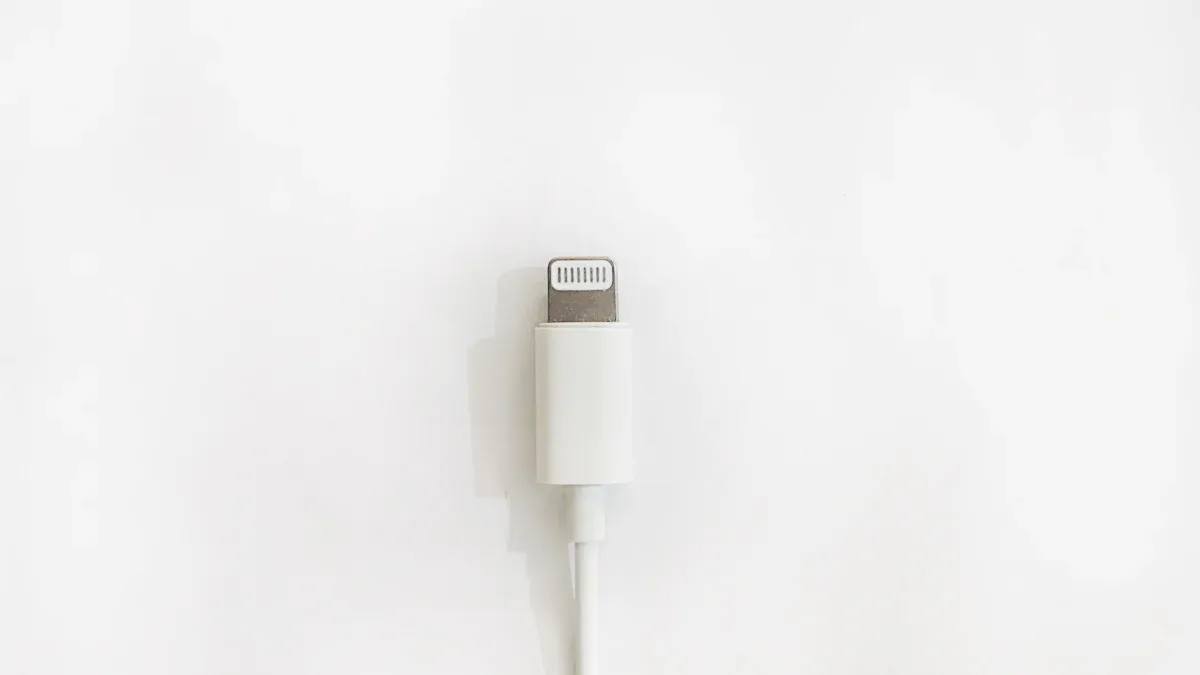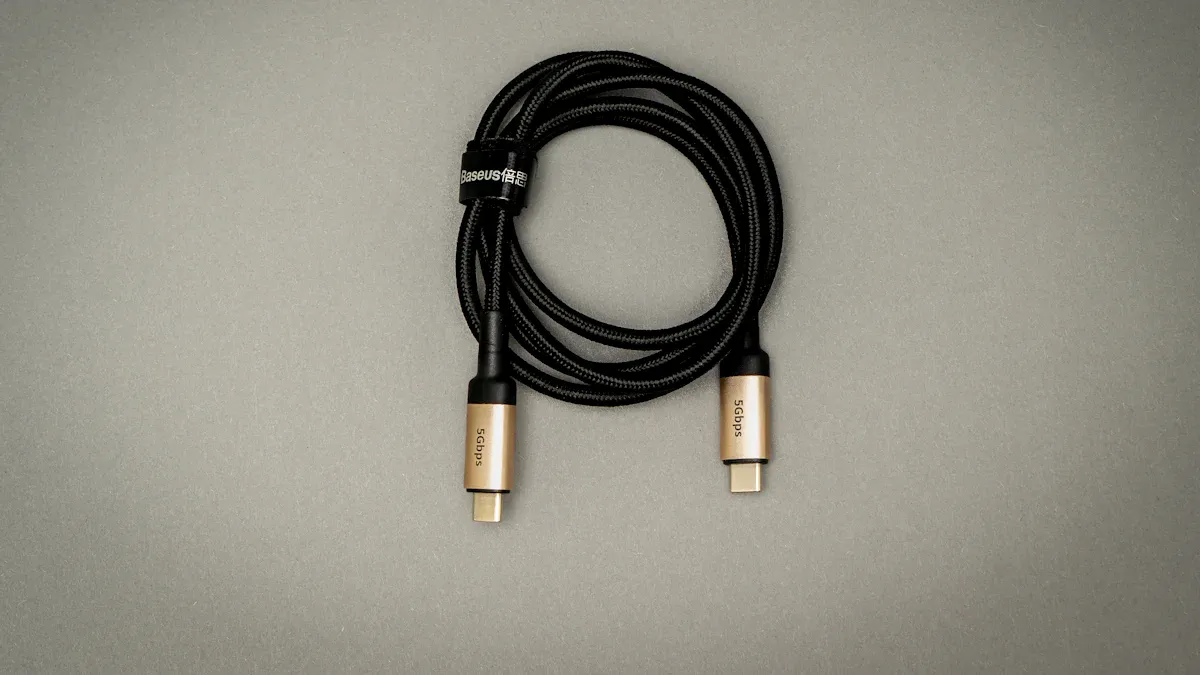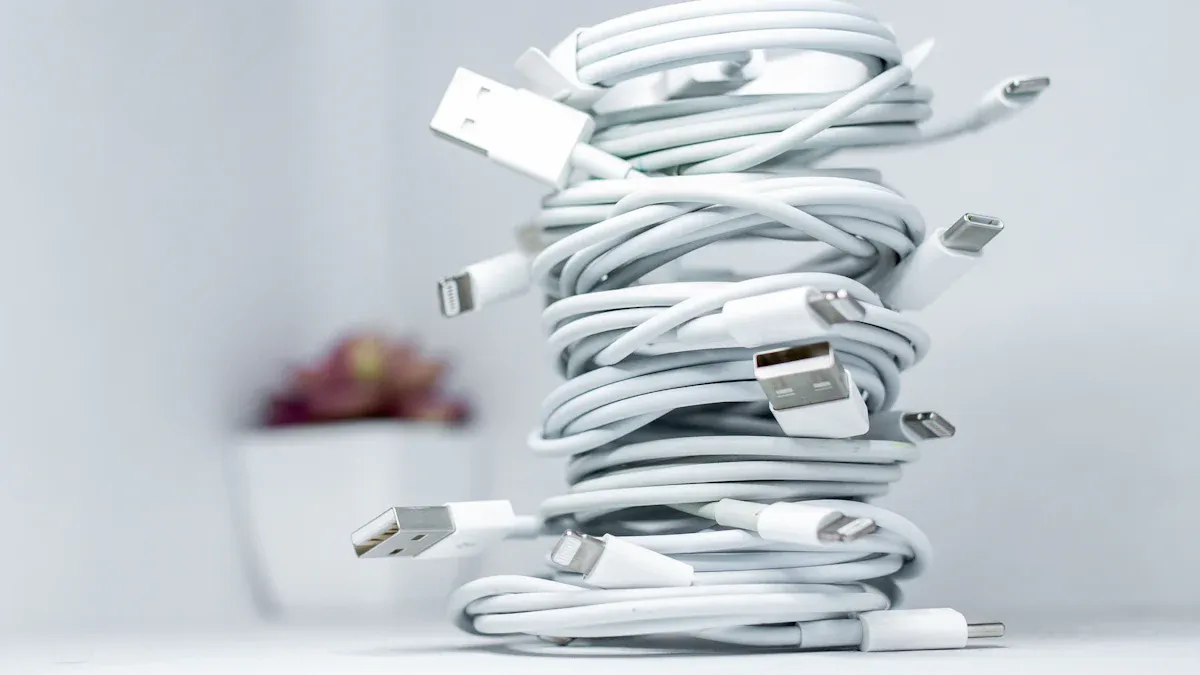The USB-C to Lightning Cable (2M) bridges the gap between modern USB-C technology and Apple’s Lightning devices. It’s perfect for faster charging and syncing your gadgets. Did you know cables longer than 2 meters can reduce power delivery? This 2-meter length ensures optimal speed and efficiency, meeting USB standards. It’s a must-have for your Apple ecosystem.
Overview of the USB-C to Lightning Cable
The USB-C to Lightning Cable is more than just a charging accessory. It’s a bridge between Apple’s Lightning devices and the modern USB-C standard. Whether you’re charging your iPhone or transferring files to your MacBook, this cable ensures you get the best performance. Let’s dive into its key features, technical details, and durability.
Key Features of the Cable
This cable is packed with features that make it stand out. Here’s what you’ll love about it:
– Fast Charging Support: With USB Power Delivery (PD), you can charge your devices much faster than with older USB cables.
– High-Speed Data Transfer: It supports USB 3.1 Gen 1 and Gen 2, offering speeds up to 10 Gbps. This means you can transfer large files, like videos or photos, in seconds.
– Universal Compatibility: Designed specifically for Apple devices, it works seamlessly with iPhones, iPads, and even AirPods.
– Durability: The cable is built to last, with reinforced connectors and high-quality materials that resist wear and tear.
– Optimal Length: At 2 meters, it’s long enough to give you flexibility but short enough to maintain charging efficiency.
Tip: Always look for USB IF certification when buying USB-C cables. It ensures the cable meets quality and safety standards.
Technical Specifications
Understanding the technical side of this cable helps you see why it’s so reliable. Here’s a quick breakdown:
| Feature | Description |
|---|---|
| USB IF Certification | Guarantees reliability and compatibility with USB devices. |
| Wire Gauge | Thicker wires allow for faster charging and data transfer. |
| Fast Charging | Supports Quick Charge 3.0 and Power Delivery for reduced charging times. |
| Data Transfer Speeds | Compatible with USB 3.1 Gen 1 (up to 5 Gbps) and Gen 2 (up to 10 Gbps). |
| Peak Data Transfer Speeds | High-speed USB-C cables can achieve up to 20 Gbps for USB4. |
| Advanced Standards Support | Thunderbolt compatibility allows for speeds up to 40 Gbps. |
These specs highlight why the USB-C to Lightning Cable is a must-have for anyone using Apple devices. It’s not just about charging; it’s about efficiency and performance.
Build Quality and Durability
When it comes to durability, this cable doesn’t disappoint. Manufacturers have focused on using advanced materials and production techniques to make it last longer. Here’s what makes it tough:
– Reinforced Connectors: The connectors are designed to withstand repeated plugging and unplugging.
– Braided vs. Non-Braided Options: Braided cables offer extra protection against fraying, while non-braided ones are lightweight and flexible.
– Longevity Testing: These cables undergo rigorous testing to ensure they can handle thousands of bends and pulls.
The shift toward eco-friendly materials is also worth noting. Many manufacturers are now using sustainable materials without compromising on quality. This not only benefits the environment but also ensures you get a product that’s built to last.
Note: Avoid counterfeit cables. They may look similar but often lack the durability and performance of certified ones.
Compatibility with Devices and Power Adapters
Apple Devices Compatible with the Cable
The USB-C to Lightning Cable works seamlessly with a wide range of Apple devices. Whether you’re charging your iPhone or syncing your iPad, this cable ensures reliable performance. Here’s a quick list of compatible devices:
– iPhone (all models with a Lightning port)
– iPad (including iPad Air and iPad Mini)
– AirPods and AirPods Pro
– Magic Mouse, Magic Keyboard, and Magic Trackpad
– Siri Remote
– iPod touch
This cable is designed exclusively for Apple’s ecosystem, making it the perfect choice for your gadgets. If you’re using a MacBook, you can even connect your iPhone or iPad to transfer data quickly and efficiently.
Tip: Always check your device’s port type before purchasing a cable to ensure compatibility.
Supported USB-C Power Adapters
Pairing your USB-C to Lightning Cable with the right power adapter is key to unlocking its full potential. Apple recommends using USB-C power adapters that support Power Delivery (PD) for faster charging. Here are some options:
– Apple’s 20W USB-C Power Adapter
– Apple’s 30W, 61W, or 96W USB-C Power Adapters (ideal for iPads and MacBooks)
– Third-party USB-C PD adapters with MFi certification
USB-C’s universal compatibility means you can use adapters from other brands, but make sure they meet Apple’s standards. This ensures safe and efficient charging for your devices.
Note: Avoid using low-quality adapters, as they may damage your cable or device.
Limitations and Incompatibilities
While the USB-C to Lightning Cable offers excellent compatibility, it does have some limitations. Apple’s proprietary fast charging protocols don’t always work with third-party accessories unless they’re reverse-engineered. The Lightning connector includes an authentication chip, which restricts compatibility with uncertified cables and adapters.
Additionally, some advanced technologies, like GaN-based chargers, may face challenges when paired with this cable. These issues stem from differences in material properties compared to traditional silicon-based chargers.
If you’re using non-Apple devices, keep in mind that Lightning cables are exclusive to Apple products. For universal compatibility across brands, USB-C cables are a better choice.
Alert: Always opt for certified accessories to avoid performance issues or damage to your devices.
Benefits of USB-C to Lightning Cable
Faster USB-C Charging with Power Delivery
You’ve probably noticed how frustrating slow charging can be, especially when you’re in a rush. The USB-C to Lightning Cable changes the game with USB Power Delivery (PD). This advanced technology lets you charge your devices faster than ever. Imagine going from 0% to 50% battery in just 30 minutes. That’s not just convenient—it’s a lifesaver when you’re on the go.
Here’s a quick comparison of charging times with different cables:
| Cable Type | Charging Time (0% to 50%) | Power Adapter Required |
|---|---|---|
| Silicone USB-C to Lightning Cable 6ft | 30 minutes | Apple 18W, 29W, 30W, 61W, or 87W USB-C Power Adapter |
| Belkin BoostCharge USB-C to Lightning Cable | 30 minutes | PD-enabled adapter required |
| Belkin – BoostCharge Pro Flex Braided Cable | Fast charging capability | PD-enabled adapter required |
USB Power Delivery doesn’t just stop at speed. It’s smart too. It adjusts power levels based on your device’s needs, ensuring safe and efficient charging. Plus, it supports bi-directional orientation, so you don’t have to worry about plugging it in the wrong way.
Tip: Pair your cable with a PD-enabled adapter to unlock its full potential. You’ll thank yourself later.
Enhanced Data Transfer Speeds
If you’re tired of waiting for files to transfer, this cable is here to save the day. The USB-C to Lightning Cable supports impressive data transfer speeds, making it perfect for syncing photos, videos, and other large files. With USB 3.1 Gen 1 and Gen 2 compatibility, you can enjoy speeds up to 10 Gbps. That’s fast enough to transfer an entire HD movie in seconds!
Here’s why USB-C cables outperform traditional options:
– They support speeds up to 20 Gbps with USB Power Delivery.
– They allow for intelligent power management, ensuring efficient performance.
– They’re designed for durability, so you won’t have to replace them often.
Whether you’re backing up your iPhone or transferring files to your MacBook, this cable makes the process quick and hassle-free. It’s not just about speed—it’s about convenience.
Alert: Always use certified cables to avoid compatibility issues and ensure optimal data transfer speeds.
Convenience of a 2-Meter Length
Ever struggled with short cables that limit your movement? The USB-C to Lightning Cable’s 2-meter length solves that problem. It’s long enough to give you flexibility while charging or transferring data, yet short enough to maintain efficiency.
Picture this: You’re lounging on the couch, and your phone is charging across the room. With this cable, you can comfortably use your device without feeling tethered. It’s perfect for home, office, or even travel.
The 2-meter length also makes it easier to connect your devices to hard-to-reach USB ports, like those on the back of a desktop computer. No more awkward stretching or repositioning.
Note: Longer cables can reduce power delivery efficiency, so 2 meters is the sweet spot for performance and convenience.
Choosing the Right USB-C to Lightning Cable
Factors to Consider (Length, Durability, Certification)
When picking the perfect USB-C to Lightning cable, you need to focus on three key factors: length, durability, and certification. Each plays a vital role in ensuring you get the best performance and value for your money.
First, think about the length. A 2-meter cable is ideal for most situations. It’s long enough to give you flexibility but not so long that it compromises charging efficiency. Shorter cables might limit your movement, while longer ones can reduce power delivery.
Durability is another big factor. High-quality usb-c cables, like the Anker 331, are known for their sturdy build. They often feature reinforced connectors and braided designs that resist wear and tear. However, some cables may fall short in connection reliability, so always check reviews before buying.
Finally, certification is crucial. MFi-certified usb-c cables meet Apple’s strict standards, ensuring compatibility and safety. Without this certification, you risk using a cable that could damage your device or fail to deliver stable performance.
Tip: Always choose cables with MFi certification to avoid potential issues.
Importance of MFi Certification for USB-C Cables
MFi certification isn’t just a fancy label—it’s your assurance of quality. Apple requires all MFi-certified cables to pass rigorous compliance and safety tests. This ensures they work seamlessly with your devices and won’t cause harm.
Here’s why MFi certification matters:
– Each cable includes an Apple-made authorization chip for guaranteed compatibility.
– Certified cables deliver stable performance, even during heavy use.
– Apple’s warranty doesn’t cover damage caused by non-MFi cables, so using certified ones protects your investment.
Non-MFi cables might seem like a cheaper option, but they often come with risks. They can cause inconsistent current flow, leading to data loss or even device damage. Stick with MFi-certified usb-c cables for peace of mind.
Identifying Counterfeit or Low-Quality Cables
Spotting fake or low-quality usb-c cables can save you a lot of trouble. Counterfeit cables often look similar to genuine ones, but they lack the durability and performance you need.
Here’s how you can identify them:
– Check for MFi Certification: Look for the “Made for iPhone/iPad” logo on the packaging.
– Inspect the Build Quality: Genuine cables have smooth, sturdy connectors and high-quality materials.
– Test the Performance: If the cable charges slowly or fails to transfer data reliably, it’s likely a fake.
Using counterfeit cables isn’t worth the risk. They can overheat, damage your device, or even pose safety hazards. Always buy from trusted brands or Apple’s official store to ensure you’re getting a reliable product.
Alert: If a deal seems too good to be true, it probably is. Avoid suspiciously cheap cables.
The USB-C to Lightning Cable (2M) is a game-changer for your Apple devices. It delivers faster charging, seamless data transfer, and unmatched convenience. High-quality cables ensure stability, safety, and longevity. Certified options also enhance efficiency and protect your devices. Investing in a reliable cable means better performance and peace of mind.
FAQ
What makes the USB-C to Lightning Cable (2M) better than standard Lightning cables?
The USB-C to Lightning Cable offers faster charging, quicker data transfers, and better durability. Its 2-meter length adds convenience without sacrificing performance. 🚀
Can I use this cable with non-Apple devices?
No, this cable is designed exclusively for Apple devices with Lightning ports. For non-Apple devices, you’ll need a standard USB-C cable.
How do I know if my cable is MFi-certified?
Look for the “Made for iPhone/iPad” logo on the packaging. Certified cables also include an Apple authorization chip for guaranteed compatibility.
Tip: Always buy from trusted retailers to avoid counterfeit cables.



